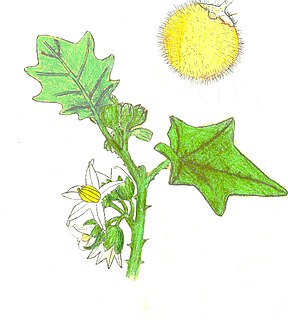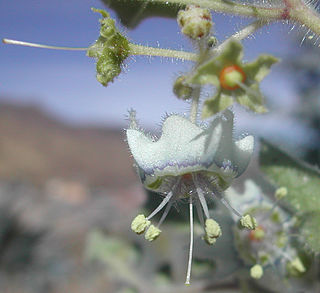
The Solanales are an order of flowering plants, included in the asterid group of dicotyledons. Some older sources used the name Polemoniales for this order.

A sepal is a part of the flower of angiosperms. Usually green, sepals typically function as protection for the flower in bud, and often as support for the petals when in bloom. The term sepalum was coined by Noël Martin Joseph de Necker in 1790, and derived from the Greek σκέπη, a covering.

Petunia is genus of 20 species of flowering plants of South American origin. The popular flower of the same name derived its epithet from the French, which took the word petun, meaning "tobacco," from a Tupi–Guarani language. An annual, most of the varieties seen in gardens are hybrids.

Solandra maxima is a flowering plant in the Solanaceae family. It is also known as cup of gold vine, golden chalice vine, or Hawaiian lily, is a vigorous vine which is endemic to Mexico and Central America. It has very large yellow flowers and glossy leaves.

Solanum melissarum is a small tree or shrub in the flowering plant family Solanaceae endemic to Brazil.

Solanum lasiocarpum, synonym Solanum feroxL., otherwise known as Indian nightshade or hairy-fruited eggplant, is a plant that produces edible fruit. Its flowers are white and its fruits are pale yellow.

Solanum diphyllum, commonly known as the twoleaf nightshade, is a species of nightshade native to the Americas. It is cultivated as an ornamental plant for its clusters of dark green round fruits that turn a bright yellow when ripe.

Dr Maarten Joost Maria Christenhusz is a Dutch botanist, natural historian and photographer.
Quercus chihuahuensis, the Chihuahua oak, is a species of oak in the beech family. It is native to the region from extreme western Texas west to Sonora and south to Zacatecas and San Luís Potosí. It grows mostly at mid elevations in forests mixed with various pines and other oaks. It is one of the dominant species of the Sierra Madre Occidental in Chihuahua and Sonora.

Jaltomata is a genus of plants in the family Solanaceae. According to molecular phylogenies, Jaltomata is the sister genus to Solanum, which includes tomato, potato, and eggplant. Jaltomata has a neotropical distribution, in that species occur from the United States southwest through Latin America, and into the Andean region of South America. Species encompass a wide range of vegetative and reproductive trait variation, including growth habit, floral size, shape and color, as well as fruit size and color. The fruits of some of the species are eaten by humans in Latin and South America. Depending on the species, fruits may be red, green, orange, or dark purple.

Jaltomata procumbens, the creeping false holly, is a plant species native to Arizona, USA, Mexico, Central America, Colombia, Ecuador, and Venezuela. It grows as a weed in agricultural fields and other disturbed locations, but in many places the people protect it because of the edible fruits it produces.
Jaltomata aspera is a plant species native to Peru. It grows on rocky hillsides at elevations less than 1800 m.

Jaltomata weberbaueri is a plant species native to Peru. It grows on rocky hillsides at elevations less than 1800 m.
Jaltomata cuyasensis is a plant species native to Peru. It grows on rocky hillsides at elevations less than 1800 m.
Jaltomata werffii is a plant species endemic to the Galápagos Islands in Ecuador. The epithet was spelled "werfii" in the original publication, but was corrected to "werffii" later, per Article 60.1 of the Code. The single "f" was a typographical error, as the plant was named in honor of Henk van der Werff.
Jaltomata grandiflora is a rare plant species native to the Mexican State of Michoacán.

Jaltomata lojae is a plant species native to Peru and Ecuador.
Jaltomata antillana, the Antilles false holly, is a plant species native to Jamaica, the Dominican Republic, Haiti, Cuba and Puerto Rico.

The Solanaceae, or nightshades, are a family of flowering plants that ranges from annual and perennial herbs to vines, lianas, epiphytes, shrubs, and trees, and includes a number of agricultural crops, medicinal plants, spices, weeds, and ornamentals. Many members of the family contain potent alkaloids, and some are highly toxic, but many—including tomatoes, potatoes, eggplant, bell and chili peppers—are used as food. The family belongs to the order Solanales, in the asterid group and class Magnoliopsida (dicotyledons). The Solanaceae consists of about 98 genera and some 2,700 species, with a great diversity of habitats, morphology and ecology.

Jaltomata cajacayensis is a plant species native to Peru. The name comes from the Cajacay District, where it was recognized by Mione as a new species.












